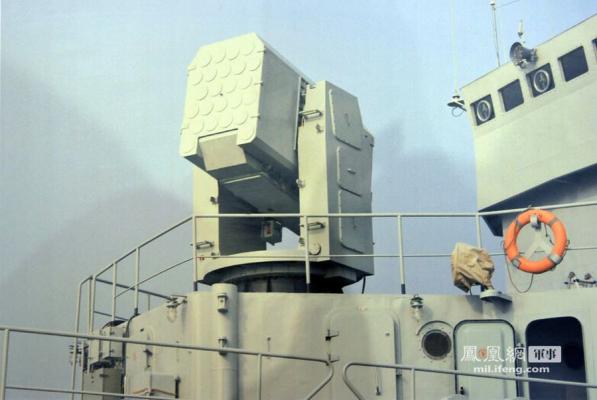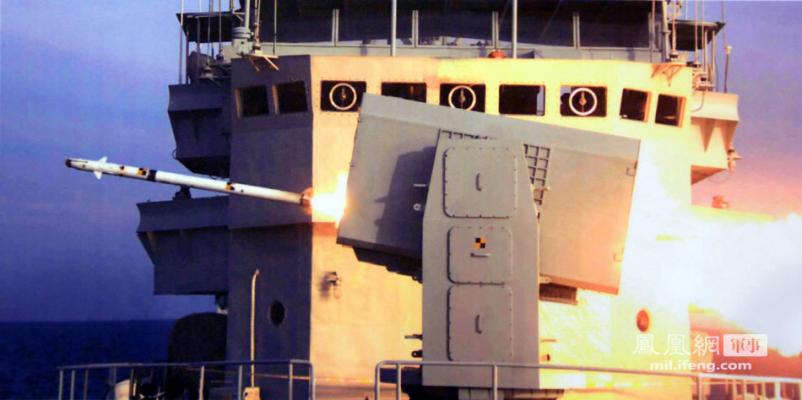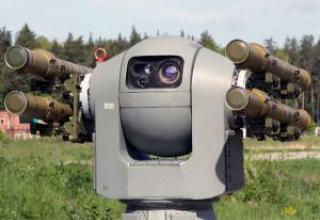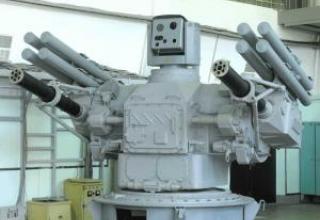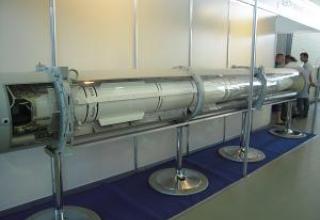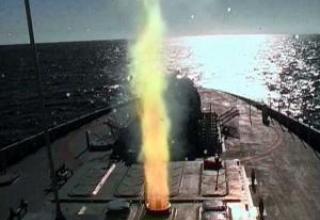Short range anti-aircraft missile system HHQ-10 (Hai HongQi-10, Naval Red Flag-10), is designed to organize the defense of surface ships of various classes in the near zone from massive attacks of low-flying cruise missiles, as well as aircraft, helicopters and unmanned aerial vehicles.
The HHQ-10 is designed by China Aerospace and Science Industry Corporation (CASIC) and is similar in design to the U.S.-German RAM SAM system for similar purposes.
The HHQ-10 air defense system, which received the export designation FL-3000N (Flying Leopard 3000 Naval), was first demonstrated in 2008 at the Zhuhai Airshow-2008. In November 2014, at the Airshow China 2014, CASIC presented three versions of FL-3000 air defense systems for 8 (see photo), 15 (see photo) and 24 (see photo) missiles.
The first ship equipped with this SAM system in 2008 was a Type 056 Corvette (see photo), the same system is installed on the 052D destroyers and 054B frigates. In 2011, the HHQ-10 SAM system was installed on the Chinese aircraft carrier Liaoning - four PU with 18 SAMs.
Composition:
Anti-aircraft guided missile (ALC) of HHQ-10 complex (FL-3000N) is developed on the basis of TY-90 air-to-air missile. Unlike its prototype, the missile has extended dimensions, increased range and is equipped with a combined guidance system, including passive radar and thermal homing heads. The guidance system is based on the radar interferometer with two antennas located at the nose of the missile (see photo). These antennas receive radio emissions from various systems of the attacking PCR.
The HHQ-10 can be used to capture a target after launch, in shot-forget mode, which allows to effectively counteract the saturation of the ship's air defense system during massive attacks of anti-ship missiles.
The Turret Launching Unit (TU) of the FL-3000N complex has special racks for 8, 15 or 24 interchangeable starting containers of the ZUR. The PU is equipped with azimuth and angle guide drives and can be equipped with a reloader with a sub deck cellar. On ships of small displacement the recharging is performed manually.
The complex control system is fully automatic, can control two PU and is integrated with other combat systems of the ship. In the event of a failure of the automatic system, the complex can be controlled manually.
The reaction time of the complex is about 10 s, the interval between the launches of the SAM system is 3 s.
Characteristics:
| Range of engagement of targets, m: - minimum - subsonic maximum - supersonic maximum |
500 6000 9000 |
| Maximum Flying Speed ZUR | 2.5М |
| Available overload | 20g |
| Weight of combat unit, kg | 3 |
| The dimensions of the ZUR, m: - length - case diameter |
2 0.12 |
Testing:
The chronicle provides the dates of publication in the sources indicated below.
On 01.09.2004, NAMEADSMO signed a $2 billion and €1.4 billion ($1.8 billion) contract with MEADS International, a joint venture, for the research and development phase of the MEADS SAM program.
01.09.2006 The PAC-3MSE interceptor missile has been selected as the main vehicle to destroy the MEADS complex.
05.08.2009 Preliminary design of all main components of the complex was completed.
01.06.2010 During the discussion of the draft U.S. defense budget for 2011, the Senate Commission on Armed Forces (SASC) expressed concern about the cost of the MEADS program, which exceeds the estimate by $1 billion and is being implemented with a delay of 18 months. The Commission recommended that the U.S. Department of Defense stop funding the development of MEADS in the event that the program does not pass the protection phase of the working draft. U.S. Secretary of Defense Robert Gates's response to the Commission informed that the schedule of the program has been agreed upon and the cost of developing, manufacturing and deploying MEADS has been estimated.
01.07.2010 Raytheon offered a package of upgrades to Patriot air defense systems in service with the Bundeswehr, which will upgrade them to MEADS by 2014. According to Raytheon's estimates, a phased modernization process would allow saving from 1 to 2 billion euros without reducing the combat readiness of the German armed forces. The German Defense Ministry decided to continue the development of MEADS SAM systems.
16.09.2010 The MEADS SAM system development program has successfully passed the protection stage of the working draft. The project was found to be in compliance with all the requirements. Protection results were sent to the countries participating in the program. The program cost was estimated at $19 billion.
22.09.2010 Within the framework of MEADS program implementation a plan of work on reducing costs for the complex life cycle was presented.
27.09.2010 The possibility of joint work of MEADS PBU with NATO Air Defence Command and Control Complex was successfully demonstrated. Combination of the NATO missile defense echelon means was carried out at a special test stand.
20.12.2010 At the Fusaro airbase (Italy) for the first time the PBU, placed on the Italian truck ARIS, was demonstrated. Five more PBU planned for use at the stages of testing and certification of the complex are in production.
14.01.2011 LFK (Lenkflugkorpersyteme, MBDA Deutschland) announced the delivery of the first launch unit of MEADS SAM system to the joint venture "MEADS International".
31.01.2011 As part of the MEADS complex, testing of the first multifunctional radar station was successfully completed.
On 11.02.2011 the US Department of Defense announced its intention to stop financing the MEADS project after 2013. The reason was the consortium's proposal to extend the development period of the complex by 30 months beyond the initially announced 110. The extension will require a $974mn increase in US funding for the project. The Pentagon estimates that the total financing will increase to $1.16bn, with the start of production postponed until 2018. However, the US Department of Defense decided to continue the development and testing phase within the 2004 budget without entering the production phase.
15.02.2011 In a letter sent to the Bundestag budget committee by the German Federal Ministry of Justice, it is noted that due to the possible termination of joint development of the complex, the acquisition of MEADS SAMs is not planned in the foreseeable future. The results of the programme implementation can be used in national programmes for the establishment of air defence/ERP systems.
On 18.02.2011, Germany will not continue the MEADS Air Defence/Programme after the completion of the development phase. According to the representative of the German Defence Office, it will not be able to finance the next phase of the project in case the USA withdraws. It was noted that the official decision to close the MEADS program has not been taken yet.
On 01.04.2011, Director for Commercial Development of MEADS International Marty Coyne reported on his meetings with representatives of several European and Middle East countries, who expressed their intention to participate in the project. Among the potential participants of the project are Poland and Turkey, which are interested in purchasing modern air defense / missile defense systems and access to technologies for the production of such systems. This would allow to complete the development program of the MEADS system, which was threatened with closure after the U.S. military department refused to participate in the production stage.
15.06.2011 Lockheed Martin supplied the first set of MICS (MEADS Internal Communications Subsystem) communication equipment designed to enable MEADS SAM nodes to work together.
16.08.2011 Testing of the software for the system of combat command, control, communication and intelligence of the complex in Huntsville (Alabama, USA) was completed.
13.09.2011 With the help of the integrated simulator complex there was performed a simulated launch of MEADS SAM system.
12.10.2011 MEADS International started complex tests of the first MEADS PBU at the test facility in Orlando (Florida, USA).
17.10.2011 Lockheed Martin Corporation delivered MICS communication equipment sets for use in the MEADS complex.
24.10.2011 The first MEADS launcher arrived at the White Sands Missile Range for comprehensive testing and preparation for flight tests scheduled for November.
On 30.10.2011 the US Department of Defense signed Amendment 26 to the basic memorandum, which involves restructuring of the MEADS program. Under this amendment, two MEADS test runs will be conducted in 2014 prior to the completion of the MEADS design and development contract to determine system performance. According to representatives of the U.S. Defense Department, the approved completion of MEADS will allow the U.S. defense agency to use the technologies created under the project in the implementation of advanced weapons systems development programs.
On 03.11.2011 the Directors of National Armaments of Germany, Italy and the USA approved an amendment to the contract providing for financing of two target interception tests for the MEADS system.
10.11.2011 At the Pratica di Mare airbase a successful virtual simulation of the defeat of aerodynamic and ballistic targets using MEADS SAMs was performed. In the course of the tests, the combat control point of the complex demonstrated the capabilities to organize an arbitrary combination of launchers, combat controls, command, control, communication and intelligence in a single network-centric system of air and missile defense.
17.11.2011 At the White Sands Missile Range the first flight test of the MEADS system was successfully performed. It consisted of a PAC-3 MSE interceptor missile, a lightweight launcher and a combat control point. During the test, the missile was launched to intercept a target attacking in the rear half space. After the task was completed, the interceptor missile self-destructed.
17.11.2011 Information was published on the beginning of negotiations on Qatar's entry into the MEADS development programme. Qatar has expressed interest in using the complex to ensure the security of the 2022 FIFA World Cup.
08.02.2012 Berlin and Rome are putting pressure on Washington to continue funding by the United States for the MEADS development program. On 17 January 2012, members of the international consortium MEADS received a new proposal from the U.S., which actually provided for the termination of funding for the program already in 2012.
22 February 2012 The Lockheed Martin Corporation announced the launch of comprehensive tests of the third MEADS system in Huntsville (Alabama, USA). Testing of the MEADS system is planned for the whole year 2012. Two MEADS PBUs are already involved in the testing of MEADS system at the airbases Pratica di Mare (Italy) and Orlando (Florida, USA).
19.04.2012 Beginning of complex tests of the first exemplary of the MEADS multifunction radar at the Pratica di Mare airbase. Earlier it was reported that the first stage of the station's testing was completed at the SELEX Sistemi Integrati SpA facility in Rome.
12.06.2012 Acceptance and acceptance tests of the autonomous power supply and communication unit of MEADS SAMs have been completed, designed for the upcoming comprehensive tests of the complex multifunctional radar station at the Pratica di Mare airbase. The second exemplary of the unit is being tested in the technical center of self-propelled and armored vehicles of the German Armed Forces in Trier (Germany).
09.07.2012 The first mobile test set of MEADS air defense systems was delivered to the White Sands missile range. The test set provides real-time virtual tests of the MEADS system to intercept targets without launching an interceptor missile for various airborne attack scenarios.
14.08.2012 On the territory of Pratica di Mare Airbase the first comprehensive tests of the multifunctional radar together with the combat control station and MEADS SAM system launchers were conducted. It is reported that the radar has demonstrated key functional capabilities, including the ability to view the airspace around the clock, capture the target and its tracking in various scenarios of combat situations.
29.08.2012 The PAC-3 interceptor missile at the White Sands Missile Range successfully destroyed a target simulating a tactical ballistic missile. Two targets simulating tactical ballistic missiles and the MQM-107 unmanned aerial vehicle were used during the test. The salvo launch of the two PAC-3 interceptor missiles provided the task of intercepting a second tactical ballistic missile target. According to the published data, all the test tasks were completed.
22.10.2012 On the territory of the Pratica di Mare airbase, the next stage of the MEADS state identification system testing was successfully completed. All scenarios of the system were tested in conjunction with the U.S. identification system "alien" Mark XII/XIIA Mode 5 radar system ATCBRBS (Air Traffic Control Radar Beacon System). The total volume of certification tests was 160 experiments. After integration of the system with MEADS multifunction radar, additional tests were performed.
29.11.2012 MEADS SAM system provided detection, tracking and interception of the MQM-107 target with an air jet engine at the White Sands missile range (New Mexico, USA). In the course of tests, the complex included: a combat control room, a lightweight launcher for PAC-3 MSE interceptor missiles and a multifunction radar.
06.12.2012 The U.S. Senate, despite the request of the U.S. President and the U.S. Department of Defense, decided not to allocate funds for the MEADS program in the next fiscal year. The defense budget approved by the Senate did not include $400.8mn required to complete the program.
On April 1, 2013, the US Congress decided to continue funding MEADS SAM system development program. As Reuters reported, the Congress approved the bill that guarantees the allocation of funds to cover the current financial needs until September 30, 2013. The bill envisages allocation of $380mn for completion of the development and testing phase of the complex, which will help avoid cancellation of contracts and negative consequences on the international scale.
19.04.2013 The upgraded detection radar was tested in the conditions of joint operation as part of a unified complex of MEADS SAM systems. During the tests, the radar provided detection and support of small aircraft, information transfer to the MEADS PBU. After its processing, the PBU provided target designation data to the MEADS multifunction radar, which performed additional search, recognition and further support of the target. The tests were conducted in the all-around view mode in the area of Hancock airport (Syracuse, New York, USA), the distance between the radars was more than 10 miles.
19.06.2013 Lockheed Martin press release informs about successful tests of MEADS air defense systems as part of a single air defense system with other anti-aircraft systems, which are in service with NATO countries.
10.09.2013 The first launch of the MEADS air defense system on the chassis of a German truck was delivered to the U.S. for testing. Two launchers are scheduled for testing in 2013.
21.10.2013 In the course of tests on the territory of the White Sands Missile Range, the MEADS multifunction radar successfully captured and escorted the target simulating the Lance tactical ballistic missile for the first time.
06.11.2013 During tests of MEADS SAM system to assess the capabilities of the complex to provide circular defense intercepted two targets, simultaneously attacking from opposite directions. Tests were conducted at the White Sands Missile Range (New Mexico, USA). One of the targets simulated a Lance-class ballistic missile, QF-4 target was a cruise missile.
21.05.2014 The MEADS system for determining the nationality of an "alien" complex received an operational certificate from the U.S. Department of Defense's Office of Air Control.
24.07.2014 Demonstration tests of the MEADS SAM system at the Pratica di Mare airbase have been completed. During the two-week tests the capabilities of the complex to work in various architectures, including under the control of superior control systems were demonstrated to the German and Italian delegations.
23.09.2014 Six-week operational tests of the multifunctional radar from the MEADS air defense system at the Pratica di Mare airbase (Italy) and at the German MBDA air defense center in Freinhausen were completed.
07.01.2015 MEADS SAM systems are considered as a candidate for compliance with the requirements for new generation air and missile defense systems in Germany and Poland.
